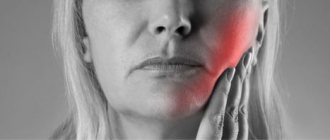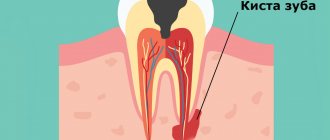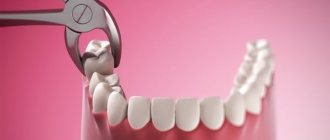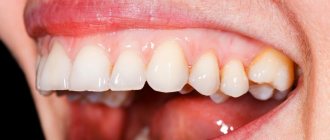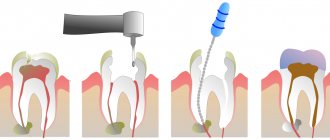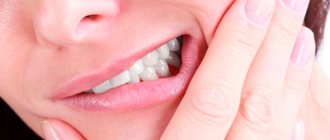Author: Brodsky Sergey Evgenievich Deputy Chief Physician, Candidate of Medical Sciences in the specialties: dentistry and medical microbiology Any person is inclined to believe that if the nerve is removed from the tooth, then it will no longer hurt. However, this opinion is not entirely true. A dead tooth can hurt, and also react to cold and hot, and this is a phenomenon called hypersthesia, increased sensitivity dental unit. These unpleasant sensations require a visit to the dentist, as they may indicate inflammation that has begun in a dead tooth or other dental problems.
Deputy Chief physician Sergey Evgenievich Brodsky
Sign up for a free consultation
+7
Why can a tooth hurt if the nerve has been removed a long time ago?
In medical practice, there are cases when a tooth that was pulpless a month, or even a year ago, suddenly begins to hurt. At first, it may be a barely noticeable discomfort, a reaction to hot or cold. However, soon the unpleasant sensations develop into acute pain, in addition, it often comes to swelling, suppuration and tumors. An unambiguous answer to the question “why does a tooth that has been healed for a long time begin to hurt?” difficult - doctors currently cite several of the most common and obvious reasons:
- Incomplete depulpation
. In other words, if for some reason the nerve was not completely removed, sooner or later it will definitely make itself felt. The process of pulp removal is very complex, requiring maximum precision and care from the doctor. In this case, experience also plays an important role - a young specialist who is thoroughly familiar with the theory is unlikely to be able to cope with this task better than a dentist seasoned by many years of medical practice. If the nerve is not completely removed, over time you will inevitably have to deal with pain and a variety of complications. By the way, if the patient has a pronounced reaction of the tooth to cold or hot, most likely it is the nerve that has not been completely removed. - Poor quality filling after depulpation.
This reason is also quite common in medical practice. For a better understanding of the situation, let us explain: the root canal of a tooth has a thickness of 0.5 to 1 mm, in an expanded form (after processing with special tools) - up to 2 mm. The shape and bends are individual for each individual channel - they can be straight, with bends, with creases. It is not always possible to see this on an x-ray, so the doctor has to work “blindly”, by touch. It is not surprising that in some cases part of the canal remains unfilled. And it is in this part that bacteria accumulate over time, causing inflammation and leading to pain. Also, the filling itself may not lie tightly, allowing access to pathogenic microorganisms. - Increased pressure on the tooth
. The tooth does not just stand in the jaw bone - it is attached to it by numerous threads of connective tissue. If during the filling process the doctor installs a filling that is too high, then the chewing load on this tooth will increase significantly, which, accordingly, will increase the load on the ligaments. Over time, the increased pressure will turn into a constant aching pain, especially evident when pressed. - Infection
. If we assume that the nerve has been completely removed and all the canals have been thoroughly cleaned and securely sealed, there is only one option left - the activity of pathogenic bacteria that entered the root canals and then into the jaw tissue during the treatment of caries or pulpitis. - Insufficient hygiene
. After high-quality depulpation, the patient needs high-quality regular oral hygiene. Even under the most reliable filling, bacteria can accumulate over time if you do not brush your teeth in a timely manner. Some patients believe that dental plaque does not accumulate on the filling material and is not afraid of tartar. In fact, this is not so - bacteria have an equally destructive effect on both tooth enamel and artificial fillings. The infection can get to the root of the tooth and from the gums - this is especially true for people suffering from periodontal diseases. - In fact, one of the neighboring “living” teeth hurts
.
Naturally, it takes time for bacteria to accumulate in an unfilled canal or for an infection to make itself felt. It is likely that a tooth can get sick in a year or after 5 years - it all depends on the degree of neglect of the problem, as well as on the individual characteristics of the body (people with strong immunity tolerate inflammation much easier, so they may not notice alarming manifestations for longer).
In any of the above cases, the tooth will have to be re-treated - the filling will have to be removed, the canals will have to be cleaned and filled again. In addition, a number of additional disinfection measures will have to be carried out.
How to get rid of hyperesthesia
As you can see, the reaction of teeth to hot and cold is just the tip of the iceberg. And, of course, the removal of this discomfort should begin with a visit to the dentist and consultation with a dentist. It will not be possible to cope with the problem at home, and if left untreated, it will lead to tooth loss.
Professional diagnosis of the cause of hyperesthesia is necessary to select the correct method of dental treatment - medicinal, hygienic, physiotherapeutic or surgical.
Depending on what led to the pathology, the doctor may choose one or more types of treatment:
- Mineralization is the saturation of enamel with substances rich in potassium, fluorine, phosphorus and other minerals.
- Fluoridation of enamel - coating it with fluoride-containing preparations.
- Fissure sealing is the sealing of grooves on the chewing surface with a sealant.
- Installation of dentures, crowns, veneers if necessary.
- Filling in the presence of a carious process.
- Treatment of periodontitis and surgical removal of gum pathology. Most often, this is its raising if the onset of the disease is due to receding gums and exposure of the cervical area.
As a rule, if hyperesthesia is in the first stage, complex treatment is not required. Fluoridation of teeth and their mineralization is sufficient. Most of the above procedures are chosen by dentists if the process has already reached stages 2 and 3.
Why can a tooth hurt immediately after nerve removal?
It also happens that immediately after the end of the anesthesia (and the procedure for removing nerves is invariably accompanied by the use of local anesthetics), the patient begins to experience acute pain in the dead tooth. There may be several reasons for this:
- The filling material got from the root of the tooth onto the soft gum tissue . This situation can occur if the material is fed into the root canals under very high pressure. In addition, this often occurs due to incorrect measurement of the channel length. To avoid this problem, it is necessary to take pictures before and after depulpation, and if defects are detected, immediately remove the filling, remove excess paste and reseal the canals.
- Remains of dental instruments in the canal . The needles for widening the canals and removing nerves are very thin. Even though modern instruments are made from high-quality materials, there is a small chance that a small piece of needle will remain in the canal, causing discomfort and pain.
- Damage to the tooth root . During the process of cleaning canals and removing nerves, there is a possibility of drilling through the root of the tooth, resulting in an open cavity leading directly into the jawbone (which, by the way, can also be damaged due to drilling too deep).
- The body's reaction to filling material . Or simply an allergy. Anyone can encounter this, especially if the patient has not previously had to deal with dental intervention. In this case, it is necessary to urgently remove the filling and repeat the procedure using a different material.
All of the above causes of tooth pain after nerve removal are pathological and require urgent medical intervention.
It is important to understand that immediately after treatment, a tooth with a removed nerve may hurt for some time for a number of reasons:
- Depulpation is a process of violating the integrity of nerve tissue, which cannot be completely painless. After the local anesthesia wears off, the patient still feels discomfort and aching pain for some time, which can be relieved with toothache tablets.
- A reaction to cold and hot things in the first couple of days after nerve removal is normal. Due to the violation of the integrity of the tooth tissue, its sensitivity also increases, which goes away after complete healing.
In order for the recovery period to pass quickly and painlessly, it is necessary to strictly follow the recommendations of the attending physician - do not drink or eat for 2 hours after the operation, observe the rules of hygiene, take anti-inflammatory and painkillers.
When should you see a doctor?
Dentists themselves recommend not delaying a visit to the clinic if the slightest alarming symptoms occur:
- Acute throbbing pain in the first hours after depulpation.
- The presence of edema, a swollen cheek or gum, the formation of an abscess under a tooth without a nerve.
- Manifestation of tooth reaction to cold and hot long after dental intervention.
- The pain after the operation does not subside, but on the contrary, it becomes stronger.
- An increase in body temperature (indicates the presence of an inflammatory process).
- Pain when pressing on a tooth or chewing.
If you contact an experienced doctor in a timely manner, any problems can be solved as soon as possible.
Diagnostics
If a patient complains of tooth sensitivity to cold, hot, sweet and sour foods, the doctor may immediately suspect hyperesthesia. The disease can be diagnosed after a visual examination of the patient's oral cavity. During the examination, the doctor may note changes in the structure of the hard tissues of the tooth, as well as changes in the condition of the periodontium. Usually there is a decrease in hard tissue at the cutting edge (front teeth) or on the chewing surface (back teeth).
Differential diagnosis of hyperesthesia lies in the ability to distinguish the symptoms of tooth sensitivity from the symptoms of acute pulpitis. In acute pulpitis, pain is prolonged, pain occurs mainly at night. With hyperesthesia, the pain is short-term, occurs directly from chemical or thermal irritation of the tooth and goes away almost immediately.
Why does a tooth hurt when pressed?
If the tooth does not bother you until you start chewing or pressing on it, most likely the reason lies in problems with the ligaments that “attach” the tooth to the jawbone, or due to slight swelling that will subside in a few days.
However, there are other reasons:
- A fragment of a dental needle remained in the canal.
- Excess filling material has gone beyond the root of the tooth and landed on the jaw bone.
- The nerve was not completely removed (in this case the tooth hurts even with light tapping).
- During the treatment of caries, an infection got into the root canals.
If you feel a sharp pain when pressing, it hurts to chew and even speak, you must urgently go to the clinic, take an x-ray and repeat the operation to clean and fill the canals, having previously eliminated possible foci of inflammation.
We correct other people's mistakes. Dental retreatment with a 10% discount
Moscow
What complications may arise?
Pain is one of our body's defense mechanisms. If there is pain, it means one of the systems is not working correctly, and there is a certain pathology. If you do not pay attention to these signals for help in time, you may encounter serious complications:
- Inflammation under the tooth
. At first it will be concentrated in one place. But in the absence of proper treatment, it will spread to nearby tissues, and then, through the bloodstream, throughout the body. - Infection of adjacent teeth
. If the cause of the pain is the proliferation of pathogenic bacteria, it is likely that the infection will spread to the soft tissue of the gums and then spread throughout the entire oral cavity.
If, after removing a nerve, a wisdom tooth hurts, then, contrary to popular belief, it is not necessary to remove it - if it is possible to repeat the treatment, eliminating the source of infection and inflammation, the doctor will definitely do everything in his power to save the tooth.
In the most advanced cases, the doctor usually decides to remove the filled tooth.
When to sound the alarm
Mild soreness after nerve tissue removal is normal. After all, the canals are expanded, their shape is changed in order to be densely filled with a filling compound.
Mild discomfort that persists in the first few days is what doctors call post-filling pain. It does not require special treatment. If necessary, the patient can take painkillers.
During the depulpation procedure, microtraumas are inevitable. The tissues need to be given time to recover. Within two or three days there will be no trace of post-filling discomfort.
This is what the symptoms look like, indicating that the regeneration processes are not going according to plan:
- the pain persists after five to seven days, it is sharp, severe, and interferes with leading a normal lifestyle;
- analgesics do not relieve symptoms immediately and for a short time (sometimes they are completely useless);
- body temperature is increased;
- the gums in the area of the problem unit become inflamed and swollen;
- headache;
- the pain spreads to neighboring teeth, sometimes it is difficult to understand which zone is its source.
With these signs, you need to determine the cause of the problem as soon as possible. To do this, you should seek medical help. The doctor will conduct a diagnosis and tell you what to do to speed up regeneration.
How to relieve pain?
The process of treating a damaged tooth is very complex and time-consuming. It often takes several visits to the doctor to completely eliminate the cause of the pain. At the same time, in order to somewhat reduce pain, it is quite acceptable to use painkillers, especially considering the fact that most of them also have an anti-inflammatory effect:
- Ibuprofen.
- Aertal.
- Ketanov.
- Nimesil.
- Nise.
- Paracetamol (may help with moderate pain).
In addition, you can numb an open tooth using special lidocaine-based sprays.
Don’t forget: pain relief is just a means to eliminate discomfort, but unfortunately, no pill, even the strongest and highest quality, can cope with the source of the disease.
Treatment of a dead tooth in dentistry
During the first visit to the dentist, the patient is usually sent for an x-ray, which will help determine the possible causes of pain in the pulpless tooth. Next, the doctor acts based on the current clinical situation:
- The dead tooth is opened and the remaining filling is removed from the canals.
- If there are remnants of nerve endings in the pulp, complete depulpation is performed.
- The root canals are thoroughly disinfected.
- Finishing the channels, cleaning and polishing them.
- Filling of root canals. If there is a one-stage treatment, the doctor uses a filling paste. If there is a need to eliminate the source of infection and inflammation, the dentist will install a temporary filling, which will be replaced with a permanent one in 2-3 weeks.
- Restoring the final shape of the tooth. Restoration work is no less complex a process than canal filling. If the permanent filling turns out to be higher than it should be, an additional chewing load will be placed on the tooth, which may cause discomfort and pain to arise again over time.
It may seem that treating a dead tooth is much easier than depulping a live one. In fact, the opposite is true - finding and eliminating an existing defect is much more difficult than doing all the work on treating a tooth “from scratch.”
Indications for root canal treatment
Acute throbbing pain in a tooth is a marker of inflammation. Against this background, the following symptoms should alert you:
- swelling of the gums and cheeks;
- flux formation;
- reaction to temperature stimuli;
- fever, chills;
- increased pain when biting.
Clinical manifestations are a reason to return to the dentist, otherwise there is a high risk of losing a dental unit. If defects are detected, repeated radiography, removal of the filling, cleaning and obturation of the canal are necessary.
Prevention
If for some reason you had to depulpate a tooth, you should not think that now it will never bother you again - without proper preventive measures, the likelihood of pain is very high. To avoid complications, follow simple rules:
- Do not eat or drink for 2 hours after surgery - this will reduce the risk of infection under the filling. Smoking and drinking alcohol are not recommended for at least 24 hours after treatment.
- Take anti-inflammatory pain medications as recommended by your dentist.
- At first, try to reduce the chewing load on the pulpless tooth.
- Regular hygiene. Immediately after treatment, buy a toothpaste to reduce tooth sensitivity. In the future, brush your teeth 2 times a day, do not neglect dental floss and mouth rinses.
- Professional hygiene. Visit your dentist at least once every six months. Make an appointment for a professional plaque and tartar cleaning once a year. To protect your teeth from adverse external influences, go through the procedure of fissure sealing, and to strengthen the enamel - remineralization or fluoridation.
And remember - everything in our body is interconnected. Don’t wait for pain – at the first signs of discomfort after dental treatment, contact your doctor immediately.
Author: Elena Kopylova Dentist-therapist, endodontist, pediatric dentist. Work experience more than 7 years. The information is for reference only. Before treatment, consultation with a doctor is necessary.
What to do if your teeth begin to react to heat?
The first manifestations of hyperesthesia are barely noticeable and fleeting. At first, the sensation can hardly be called pain; rather, it is a slight discomfort that can easily be avoided by giving up the habit of drinking scalding tea or coffee. But it’s better to consult a dentist. The doctor will assess the condition of the enamel, identify the cause of increased sensitivity and prescribe treatment that is suitable for you.
Treatment at home
For increased sensitivity of teeth to hot foods and drinks, traditional medicine recommends using clove and tea tree oils. They can be used to lubricate a problematic tooth without diluting. Or add 3-4 drops to a glass of warm water and rinse your mouth with the solution several times a day.
Well-chosen toothpastes give a good effect:
- Lacalut Sensitive;
- Sensodyne Repair & Protect;
- SPLAT "Biocalcium";
- Aqua Oxygen Mineral Cocktail.
They contain special components that fill microcracks, and sometimes long-acting anesthetics. Of course, toothpastes cannot cure enamel erosion, cope with increased abrasion and other dental problems. But if the enamel has not yet become too thin, they will help you survive an unfavorable period (pregnancy, spring vitamin deficiency, stressful situations) with minimal losses.
Toothpastes for sensitive teeth can be used for more than just brushing. You can simply lubricate your teeth with them to quickly relieve pain.
Treatment in dentistry
A doctor has many ways to overcome hyperesthesia. First of all, the dentist will try to identify the problem of his profile: periodontal disease, caries, non-carious enamel lesions. If there are any, the patient will have to treat the detected pathologies.
If the teeth are healthy, and the patient complains of pain from hot foods, the dentist will recommend contacting a therapist, and then specialists to identify the causes of the problem. And to improve the quality of life, it will seal the dentinal tubules with remineralizing agents, sealants, and desensitizers.




